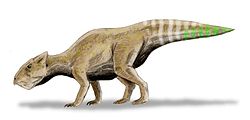| Javkhlant Formation | |
|---|---|
| Stratigraphic range: Santonian-Campanian ~ | |
 Khugenetjavkhlant locality | |
| Type | Geological formation |
| Overlies | Bayan Shireh Formation |
| Thickness | 380 m (1,250 ft) |
| Lithology | |
| Primary | Mudstone |
| Other | Sandstone, conglomerate |
| Location | |
| Coordinates | 44°24′N109°24′E / 44.4°N 109.4°E |
| Approximate paleocoordinates | 44°36′N98°48′E / 44.6°N 98.8°E |
| Region | Dornogov |
| Country | Mongolia |
| Type section | |
| Named by | Khand et al. |
| Year defined | 2000 |
The Javkhlant Formation is a geological formation in Mongolia whose strata date back to the Late Cretaceous possibly Santonian to Campanian. Ceratopsian, ornithopod and theropod remains been found in the formation. A prominent fossilized therizinosauroid nesting site is also known from the formation.



